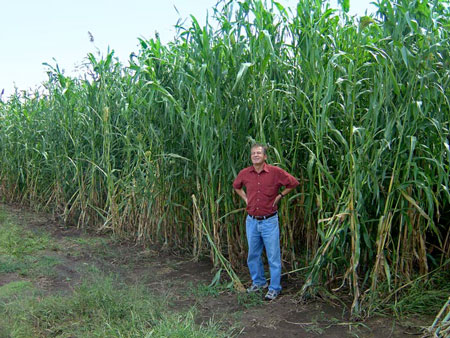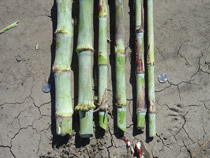
Ismail Dweikat
Sweet Sorghum UNL Hybrid 1 seed for sale. Contact Ismail Dweikat for more information.Sweet sorghum is a drought-tolerant feedstock with the potential to produce more ethanol/acre than corn

Sweet sorghum stalks contain up to 75% juice, varying between 12 and 23% in sugar. There's enough juice in an acre of sweet sorghum to make 400 to 800 gallons of ethanol. Sorghum juice-derived ethanol is cheaper to produce than corn ethanol because it doesn't require the cooking and enzymes that corn requires for conversion of starch to sugar to fuel grade alcohol. Current estimates suggest that intensive plant breeding and cultivation research could, over time, increase the sugar content of sorghum juice to a level needed to produce 1000 gallons of ethanol per acre. We plan to evaluate the potential of sweet sorghum as an ethanol-producing crop for Nebraska.
Sweet sorghum is a perennial crop in areas that don't have a winter freeze. Plant breeding efforts continue to improve the cold tolerance of sorghum for growth in the Midwest. In the Corn Belt, sweet sorghum grows 10 to 15 feet tall during a growing season. The taller the plant and the thicker the stalk, the more juice the plant will produce. To maximize juice and ethanol production in the Corn Belt, growers need to plant the crop early to mid-April. The grower could then make the first cutting for juice in early July, when the crop starts to flower. A second cutting could be made in October, shortly before frost, yielding enough juice for an additional 100 to 200 gallons of ethanol. Or, if feed were short, the grower could hay or graze the second cutting. Sweet sorghum's energy-savings and value emerge in several ways:
- The crop only needs 12-15 inches of rain during the growing season to make a crop. Therefore, it is suitable for dryland production or limited irrigation. If the crop receives more moisture, it will respond positively.
- It requires only 40-60 lbs of nitrogen per acre. The crop is long-rooted and can extract residual nitrogen left by previous crops, or from nitrogen-fixing soybeans preceding in rotation.
- Sweet sorghum juice doesn't require the long fermentation and cooking time needed to process corn ethanol.
- Some of the crop residue left after juice extraction (called bagasse) can be dried and burned to fuel ethanol distillation. These residues can also be used for animal feed, paper, or fuel pellets.
- The crop needn't be grown on a farmer's best land, allowing the farmer to make use of poorer ground.
- The simplicity of ethanol production from sweet sorghum could lend itself to on-farm or small-cooperative efforts at fuel-making.
- Ethanol plants in the State could choose, with some additional equipment, to make seasonal runs of sweet sorghum juice.
Ethanol is currently processed from sweet sorghum in Texas, Oklahoma, and Iowa, as well as India and other parts of the world. We seek to enhance sweet sorghum performance on marginal lands, and to identify a strategy for improving its ethanol processing potential, two key components for developing this system for production in Midwest region.
University of Nebraska's efforts to improve sweet sorghum's yield potential as an ethanol feedstock

- Perform life-cycle analysis of sweet sorghum and triticale-ethanol systems for net energy yield, efficiency, and potential to mitigate greenhouse gasses as compared to other biofuels, such as corn grain-ethanol and petroleum-derived gasoline.
- Conduct chemical and fermentation analysis of a) sweet sorghum sap for maximum conversion to ethanol and b) sorghum stover for cellulosic ethanol production.
- Sweet sorghum stover also serves as an excellent feedstock for ethanol production. Stover contains lignin, hemi-cellulose, and cellulose. The hemi-cellulose and cellulose are enclosed by lignin (which contains no sugars), making them difficult to convert into ethanol, thereby increasing the energy requirement for processing. The brown midrib (bmr) mutants of sorghum have significantly lower levels of lignin content (51 percent less in their stems and 25 percent less in their leaves). Research showed 50 percent higher yield of the fermentable sugars from the stover of certain sorghum bmr lines after enzymatic hydrolysis. Therefore, the use of bmr cultivars would reduce the cost of biomass-based ethanol production and these lines will be incorporated into our experimental approach. We have moved two bmr genes to sweet sorghum line and hybrids.
-
We have identified genetic variation for cold tolerance in sorghum. The improved lines have the capacity of germination at 50o soil temperature. Because of these traits, we have been able to plant our sorghum trails in the first two weeks of April for the past three years. Due to this, growers will be able to plant their sorghum crops at the same time they plant their corn. Usually, we have to wait till the second week of May to plant the sorghum crop. We also have introduces into sorghum genes that confer stress resistance (cold, drought and salt stress) from other crops via genetic transformation.

Sorghum stalks range in diameter from 4.5 to 1.5 cm. - We are also selecting for non-flowering high sugar types in order to extend the growing season and total biomass. Beside the non-flowering type, we are developing sterile F1 hybrids.
- To develop management practices that achieve high water and nitrogen use efficiency while maintaining high sugar yields in sweet sorghum. Because sorghum harvested for biomass can be harvested before maturity, it is possible to grow it in a double-crop sequence with a winter annual. Hairy vetch (Vicia villosa Roth) is a moderately winter-hardy legume that can be seeded in fall and reach maturity by early summer. Hairy vetch is capable of producing as much as 3-5 tons/acre and leave up to 100 lb on nitrogen in the soil which sufficient to grow a full crop of sweet sorghum. Vetch will be planted in October after the sweet sorghum harvest, and will be harvested in early May followed by a sweet sorghum planting on May 15.